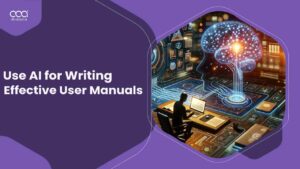In the rapidly evolving landscape of technical documentation, finding innovative ways to streamline the writing process is essential. This concept revolves around leveraging AI-powered software to simplify complex writing tasks, enhance accuracy, and boost productivity.
By introducing the right AI tool into the technical writing workflow, writers can automate mundane tasks, focus on creating high-quality content, and meet the increasing demands for clear, concise, and informative documentation in various fields.
This article will detail how to streamline technical writing with AI writing tools in UK. Moreover, we will walk you through a detailed step-by-step guide, define how to use AI tools for technical, and all the essential information related to it.
How to Streamline Technical Writing with AI Writing Tools in UK for 2024: Step-By-Step Guide
Streamlining technical writing by using the best AI writing tools in UK is a dynamic process that integrates cutting-edge technology to enhance efficiency, accuracy, and productivity in creating technical documents.
This guide, how to streamline technical writing with AI writing tools in UK, outlines a step-by-step approach to harnessing AI in technical writing, ensuring a seamless transition towards more innovative and effective documentation practices.
Step 1: Identify Your Technical Writing Needs
Begin by assessing the specific requirements of your technical writing projects. Understand the types of documents you need to produce, the audience for each document, and the complexities involved. This initial assessment will guide you in selecting AI tools that best match your project’s demands, whether it’s for grammar correction, content generation, or data analysis.
Step 2: Explore and Select AI Writing Tools
Research and explore AI writing tools according to needs that are available in the market, such as Grammarly for grammar and style checking, Jasper.ai for content creation and optimization, and QuillBot for rephrasing and summarizing. Evaluate each tool’s features, usability, and how they align with your writing needs. Consider factors like cost, compatibility with other software you use, and the learning curve involved.
Step 3: Integrate AI Tools into Your Workflow
Once you’ve selected the AI tools, integrate them into your technical writing workflow. This may involve installing software, adding browser extensions, or accessing cloud-based platforms. Familiarize yourself with the functionalities of each tool and customize settings to suit your writing style and preferences. Effective integration ensures that the tools complement your writing process rather than complicate it.
Step 4: Leverage AI for Drafting and Editing
Utilize AI tools to assist with drafting and editing your technical documents. Allow AI-driven content generators to help you create initial drafts or sections of complex documents. Use grammar and style checkers to refine your writing, ensuring clarity and coherence. AI tools can also suggest improvements in sentence structure, vocabulary, and technical jargon, enhancing the overall quality of your documentation.
Step 5: Conduct Consistency and Accuracy Checks
AI software can be invaluable in conducting consistency and accuracy checks across your documents. Leverage these tools to ensure that technical terminology is used consistently and accurately throughout your writing. AI-driven analysis can also help identify any discrepancies or errors in data presented, ensuring your documents are reliable and trustworthy.
Step 6: Optimize Document Structure with AI
Take advantage of AI tools that offer structural organization features. These can assist in outlining your documents, organizing content logically, and ensuring a coherent flow of information. AI-driven suggestions can help identify areas where additional information is needed or where content can be condensed for brevity and clarity.
Step 7: Review and Revise with AI Feedback
Finally, use AI tools to obtain feedback on your writing. AI-driven analytics can provide insights into readability, engagement, and technical accuracy. Use this feedback to make informed revisions, enhancing the effectiveness of your technical documents. Continuous review and revision with AI assistance ensure your writing remains top-notch and fulfills its intended purpose.
What is Technical Writing?

Technical writing is a specialized form of communication designed to explain complex information in a clear and accessible manner. This type of writing is crucial in various fields, such as engineering, science, technology, and more. Here’s a brief overview:
- Focuses on clear, concise, and accurate information delivery.
- Utilizes a structured format to guide the reader through instructions, descriptions, and explanations.
- Employs diagrams, charts, and other visual aids to complement textual content.
- Adheres to specific industry standards and guidelines to ensure consistency and reliability.
- Aims to make technical or complex information understandable for its intended audience, regardless of their prior knowledge.
What is AI, and What Can It Do for Technical Writers?

Artificial Intelligence (AI) stands at the forefront of technological advancement, offering tools that can significantly aid technical writers in understanding how to streamline technical writing with AI writing tools in UK. AI can automate mundane tasks, spot errors with greater accuracy than the human eye, and even generate content under certain parameters.
For technical writers, this means:
- Enhanced efficiency through automation of repetitive tasks.
- Improved accuracy in grammar, spelling, and syntax.
- Assistance in generating initial drafts or sections of documents.
- Tools for ensuring consistency across large documents or multiple projects.
- Capabilities for adapting content to different audiences or formats with ease.
How Can AI Software Help to Write Technical Documents?
AI software is revolutionizing the field of technical writing by leveraging cutting-edge technologies to enhance the writing process. From drafting to final proofreading, AI tools provide a suite of capabilities designed to improve the quality and efficiency of technical content.

Below, we delve into each aspect of how AI software can aid technical writers, highlighting the benefits and functionalities offered.
Natural Language Processing (NLP)
Natural Language Processing (NLP) is a cornerstone of AI software, enabling machines to understand and interpret human language. In technical writing, NLP can significantly enhance the readability and clarity of documents.
- Contextual Understanding: NLP analyzes the context of sentences to offer relevant improvements, ensuring that the content makes sense in its specific technical field.
- Language Optimization: It suggests synonyms and rephrases to improve clarity and engagement, making complex information more accessible.
- Tone Consistency: Ensures the document maintains a consistent tone, which is crucial for professional and technical documents.
- Enhanced Comprehension: By understanding the nuances of language, NLP can make technical documents easier for a broader audience to understand.
Error Detection

AI-driven error detection is a key component in how to streamline technical writing with AI writing tools in UK. It goes beyond traditional spell checkers by identifying and correcting complex grammatical, syntactical, and spelling errors, thereby enhancing the document’s overall quality.
- Advanced Grammar Checks: Identifies complex grammatical issues often overlooked in conventional proofreading.
- Syntax Optimization: Offers suggestions to improve sentence structure, making the content more readable and engaging.
- Spell Check: Catches and corrects spelling errors, including those specific to technical terminology.
- Punctuation Accuracy: Ensures the correct use of punctuation marks, enhancing the readability of technical documents.
Content Generation
AI software can assist in the initial drafting of document sections, providing a foundation that writers can refine and expand upon, which streamlines the content creation process.

- Quick Drafting: Generates outlines or draft sections, saving time on initial content creation.
- Idea Generation: Offers suggestions for topics or headings based on the document’s overall theme.
- Customization: Tailor content generation to fit the document’s style and technical requirements.
- Enhanced Productivity: Enables writers to focus on refining and enhancing the AI-generated content rather than starting from scratch.
Consistency Checks
Maintaining consistency in terminology and style is crucial in technical writing.

AI software can automatically review documents to ensure uniformity across all sections.
- Terminology Consistency: Ensures technical terms are used consistently throughout the document.
- Style Uniformity: Maintains a consistent writing style, including voice and tense, across different sections.
- Automated Review: Quickly scans the entire document to identify and highlight inconsistencies.
- Guideline Adherence: Helps writers adhere to specific style guides or corporate documentation standards.
Research Assistance
Compiling and synthesizing information from various sources can be time-consuming.

AI software can automate these tasks, making research more efficient and comprehensive.
- Data Collection: Gathers information from a wide range of sources quickly and efficiently.
- Source Verification: Helps verify the credibility of information and sources.
- Information Synthesis: Assists in integrating research findings into the document cohesively.
- Citation Management: Automatically formats citations and references according to various style guides.
Structural Organization
A well-organized document is easier to understand and follow.

AI tools can aid in structuring documents for better flow and coherence, enhancing the reader’s comprehension.
- Logical Flow: Suggests an organizational structure that enhances the document’s logical progression.
- Outline Creation: Helps create detailed outlines, and plan and organize content before writing begins.
- Section Optimization: Recommends the best placement for sections and subsections for optimal readability.
- Cohesion and Coherence: Ensures that all parts of the document are well-connected and coherent, facilitating smoother transitions between sections.
Real-Time Feedback
Real-time feedback from AI software can guide writers in improving their writing style, making adjustments as they write to enhance the document’s overall quality.

- Style Improvements: Offers immediate suggestions on writing style, helping to maintain a clear and engaging tone.
- Readability Enhancements: Provides feedback on sentence length and complexity to improve document readability.
- Engagement Tips: Suggest ways to make the content more engaging and interesting for the reader.
- Adaptability: Feedback adapts to the specific genre and style of technical writing, ensuring relevance and applicability.
The Best AI Software Tools For Technical Writers
In technical writing, certain AI software tools have distinguished themselves by offering invaluable assistance in refining, generating, and organizing content under the guide of how to streamline technical writing with AI writing tools in UK. These tools are indispensable for writers looking to enhance the quality and efficiency of their documentation processes.
Grammarly
Grammarly is a widely recognized AI-powered writing assistant that specializes in detecting grammatical, punctuation, and style errors. It offers real-time suggestions to improve the overall quality of writing.

Its advanced algorithms analyze the context of sentences to provide tailored recommendations, making it an essential tool for technical writers aiming for precision and clarity.
Pros:
- Comprehensive Checks: Grammarly’s extensive database covers a wide range of grammar and style issues, ensuring thorough proofreading.
- Customization: Users can set specific goals related to audience, formality, and domain, allowing Grammarly to provide targeted suggestions.
- Integration: It seamlessly integrates with most writing platforms, including email clients, word processors, and web browsers, enhancing its utility across various applications.
Cons:
- Technical Terminology: It may struggle to recognize and correctly handle highly specialized or niche technical jargon.
- Overreliance Risk: There’s a danger of becoming too dependent on Grammarly, potentially overlooking the importance of developing one’s own editing skills.
- Subscription Cost: While there is a free version, access to the most powerful features requires a paid subscription, which may be a barrier for some users.
Jasper.ai
Jasper.ai stands out for its capacity to generate and optimize content across a wide array of formats.

Utilizing advanced machine learning algorithms, Jasper.ai can produce drafts, blog posts, and even marketing material, streamlining the content creation process for technical writers.
Pros:
- Content Generation: Offers robust assistance in drafting content, significantly reducing the time and effort required to produce initial drafts.
- Adaptability: Capable of adjusting to different writing styles and formats, making it versatile for various technical writing needs.
- Efficiency: Enhances workflow by providing quick suggestions, which is particularly useful for meeting tight deadlines.
Cons:
- Accuracy Oversight: Generated content often requires careful review to ensure technical accuracy and relevance.
- Learning Curve: New users may need time to familiarize themselves with its features and best practices for effective use.
- Cost: Access to the full range of Jasper.ai’s capabilities comes at a premium, potentially limiting its accessibility to individuals or small teams.
QuillBot
QuillBot is renowned for its paraphrasing tool, which excels in rewording text to enhance readability and conciseness.

It’s particularly effective for refining and summarizing existing content, making it a valuable asset for technical writers focusing on clarity and engagement.
Pros:
- Readability Improvement: QuillBot’s rephrasing capabilities can transform complex texts into more accessible content without losing the original meaning.
- Summarization: Offers concise summaries of lengthy documents, aiding in the quick assimilation of key points.
- Integration: Easily integrates with common writing and editing platforms, facilitating a smoother writing process.
Cons:
- Input Quality Dependent: The quality of the output heavily relies on the quality of the input text; it may not significantly improve poorly written initial drafts.
- Creative Limitations: While excellent for refinement, it might not be the best tool for generating creative or highly technical content from scratch.
- Subscription for Full Features: Access to all features, including more advanced paraphrasing options, requires a subscription, which may deter some potential users.
FAQs
How can AI be utilized in technical writing?
What training is needed for technical writers to use AI effectively?
What is the earning potential for technical writers using AI tools?
Conclusion
In conclusion, the advent of AI software in technical writing signifies a monumental shift towards more streamlined, efficient, and high-quality documentation processes.
These tools, from enhancing grammatical accuracy to generating content and ensuring consistency across documents, empower technical writers to not only expedite their workflows but also elevate the standard of their outputs.
Now that you understand how to streamline technical writing with AI writing Tools in UK, doesn’t mean you should stick to one writing style. Want to learn how AI software and tools help write different creative writing styles and domains? Check out all the articles I’ve written for the how-to guides on allaboutai.com or you can enhance your understanding of AI terms by visiting our AI glossary.





